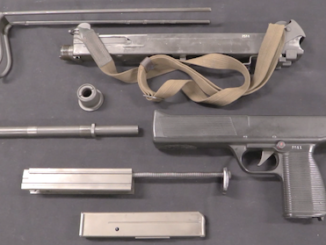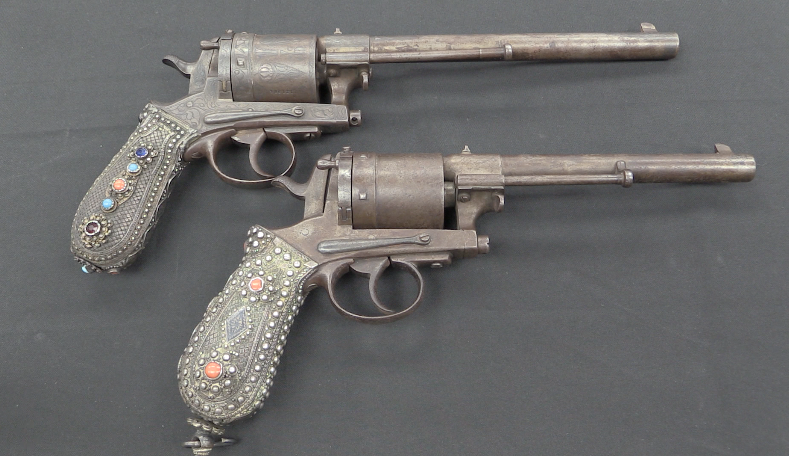Franz Passler and Ferdinand Seidl formed a partnership to make manually-operated pistols in Austria in the late 1880s, but the arrangement did not last. Their design was initially patented by Passler in Austria, and then jointly by both men in Germany. It is a rotating barrel design similar in function to the 1887 pattern Schulhof, but with a simplified internal design that makes it more durable and easier to manufacture. They also used a different magazine system, choosing a 5-round Mannlicher type clip to feed the pistol. Only about 100 pistols were made under both Passler and Passler & Seidl, and they all show minor variations – there was no commercial success achieved with the model.
Related Articles

Semiauto pistol
Looking for Some 7.65mm Mannlicher Ammo…
Update! Thanks to some leads I got, I now have 200 rounds of ammo inbound; half Argentine surplus and half modern loads made from .32-20 brass (and some great resources for other odd calibers I’m sure […]

Submachine Guns
Austria’s Take on the Uzi: Steyr MPi-69
Designed in the 1960s by Steyr and adopted by the Austrian Army in 1969 to replace it aging MP40s, the MPi-69 is an economical and simple 9x19mm SMG. It uses many features seen in the […]

Revolver
RIA: A Pair of Arresting Montenegrin Gasser Revolvers
This is quite the eye-catching pair of revolvers… The Model 1870 Gasser was a behemoth of a pistol designed by Leopold Gasser for the Austro-Hungarian cavalry – it was built around the 11x36mm cartridge used […]

A beautiful design, thanks for showing!
If I was to compare this with Schulhof, I kind of lean of former because of its rotary magazine (e.i. more integral). But this one is indeed more elegant, simpler design. Same applies for external surfaces; this is real art nouveau applied into handgun. https://en.wikipedia.org/wiki/Art_Nouveau
Btw. that Mannlicher clip should be available.
I think Colonel Sebastian Moran owned one of these
How very Austrian — a Mannlicher straight-pull bolt with a Mannlicher packet clip. Notice the hard-rubber or Bakelite grips, which had to be a marketing nod to the futuristic: No fusty old wood here!
Isn’t it amazing how much rifle, and then revolver, layout influenced mechanical and then automatic handguns? Barrel our front, mechanism (and ammo) in the middle, the space in the stocks more or less useless except perhaps to hold a spring. It took Browning’s serious out of the box thinking to rearrange the parts into a more efficient whole (with a nod to James Paris Lee via Borchardt for the box magazine pistol grip).
Sadly, it’s become trendy these days to forget the space and ergonomic efficiency of Browning’s layout, and the locked breech as well.
“(…)Bakelite(…)”
Note that method of industrial production of Bakelite was developed in latter half of first decade of 20th century and General Bakelite Company was founded in 1910
https://www.britannica.com/science/Bakelite
So anyone designing handgun in 1887 has not access to it.
“(…)Browning’s serious out of the box thinking to rearrange the parts into a more efficient whole (with a nod to James Paris Lee via Borchardt for the box magazine pistol grip).”
Did you not underestimate development in area of automatic pistols in twilight of 19th century / dawn of 20th century Europe?
Some examples of European automatic pistols with magazines inside grip are: Schwarzlose 1898, Gabbet-Fairfax Mars, Webley & Scott automatic pistol
https://modernfirearms.net/en/handguns/handguns-en/great-britain-semi-automatic-pistols/webley-scott-automatic-pistol-eng/
early Frommer automatic pistol http://hungariae.com/From01.htm
Roth-Sauer automatic pistol
Good question, what are grips made of, maybe they are aftermarket
Respectfully, please note I mentioned Borchardt (1893), I’m pretty sure the first semi-auto handgun with the magazine in the grip. I believe it predates both Browning and those on your list, to which I might add the Maxim-Silverman of 1896.
If these grips are not Bakelite, what are they?
Thank you for your expansions on my comments.
“first semi-auto handgun with the magazine in the grip”
Wait… what about Salvator-Dormus from 1891?
Agreed. I am corrected. Thank you.
Might it be another exception Schwarzlose 1898…
Might it be another exception Schwarzlose 1898… It did not have a barrel extention like rifle and had the magazine in the handle plus slide stop to hold the bolt open after last shot…
So a more complicated and expensive revolver with a weak cartridge. Why? A 10 shot clip would have been an advantage compared to a 5 or 6 shot revolver, but not this. Any idea what the rationale was behind these weapons?
I imagine that in the intended role, deterrence of robbery at bad breath range, that any gunshot was enough to do something nasty to the intended recipient. Plus, people don’t shoot each other everyday, so a gunshot would certainly attract police attention. I could be wrong.
Perhaps for the same reason as in the United States.
Someone’s patent interfered with making normal revolvers.
Or maybe it’s the cost of the technology. Such a pistol can be made using simpler and cheaper materials and tools than a revolver.
I think it was simply “in vogue” at the time. Gun makers wanted to present an alternative to revolver. As it proved later (namely by Browning’s designs) the trend was right. Pioneering is never easy.
Original grips made of walnut wood.
https://www.morphyauctions.com/jamesdjulia/item/lot-3186-rare-passler-and-seidl-repeating-pistol-53297/
What is in the video may well be a horn or an ebony variety.
Throughout the 19th Century, a substance known as Gutta-Percha was used for such things as pistol grips and boxes, tool handles, and even for sealing underwater electrical cables. It is a form of ‘rubber,’ except that it comes from a Malaysian plant instead of a tree, and is rather brittle, fragile, and not stable in higher temperatures–it gets sticky, and sags. On the other hand, it’s relatively cheap, can be dyed different colors, cast in intricate patterns and, at normal temperatures, is very hard.
If an antique pistol has ‘hard rubber’-like grips, they are almost certainly made of Gutta-Percha, not celluloid or even actual ‘rubber’.
These grips are most likely Gutta-Percha.